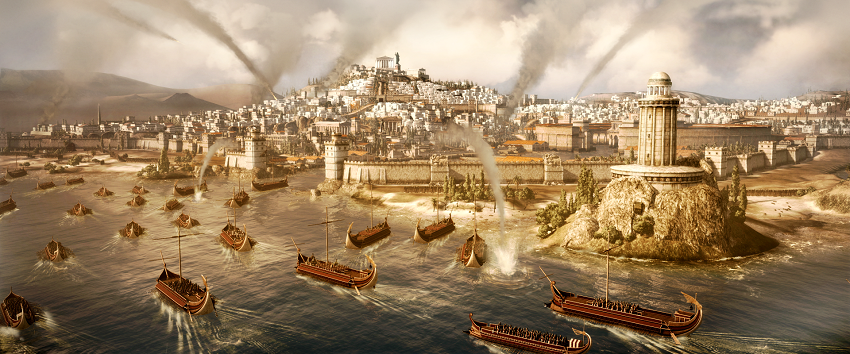It’s 146 B.C. An armada of naval ships, lead by a young Roman general named Scipio Aemilianus, is approaching the shores of Carthage, a vital trade hub for North Africa. For two years, Rome has been unsuccessful in trying to capture the well-defended city. Today, this is all about to change.
“Burn the city, Tiberius,” Scipio tells his military tribune, “No prisoners. No mercy. Kill them all.”
Carthage is a city filled with smoke and fire: Thousands of Roman soldiers already line the beach, shielding themselves from the flaming arrows falling on them. Multiple siege towers slowly march toward the city’s high walls. The camera shifts into an over-the-shoulder perspective as Scipio’s ships reach the shore, and all the soldiers are quiet except for a few encouraging words spouting from their leader. It’s a view very similar to the opening battle at Omaha Beach in Steven Spielberg’s Saving Private Ryan. This is intentional.
“We want more human level [interaction],” says James Russel, the lead designer of Total War: Rome II, during a hands-off demo of the game shown in June. “You’ve got a darker [vision] of battle where individuals react more convincingly to what’s going on…. They’re not robots. They’re real humans. We’ve got a more [effective], visceral kind of style [to reflect] the way that the Roman war machine works.”
Suddenly, the presentation zooms in on a squad of Roman soldiers inside a siege tower. You can hear the wheels turn and the wood creak against the strong, aggressive winds, which drowns out all of the battle cries from outside. “Prepare for battle men,” says a rousing general to his troops, “Remember: We fight for Rome!” The siege doors swing open on the city wall as they greet more than a dozen Carthaginian soldiers; their swords and shields clash with a satisfying crunch.
“That close-in detail is very much supported by new camera options,” says Al Bickham, the studio communications manager for The Creative Assembly. “There are times when [you can] lock the camera into a unit…and just take in everything that’s going on around them. And see the reactions of the guys who are going through that. You’re in there with them.”
The human drama of war is one of the developer’s major focuses for Total War: Rome II. In addition to introducing the idea of “combined” battlefields — naval ships bombard Carthage from a nearby harbor, and they can now capture territory along with the units on land — The Creative Assembly ultimately hopes to achieve more with less.
“We want the player to be thinking about the 10th Legion [referring to a specific squad of soldiers],” Russel says, “like the 10th legion has sustained some damage, and we need to bring up the 8th Legion to reinforce them. We don’t want them to be thinking about individual units…we want them to be thinking at an army level.
“And that’s partly a consequence of having a really big game world. We need to try and make it manageable so you’re not losing any gameplay. [Strategic] gameplay is all about interesting decisions, and you want to make those decisions more interesting and not give the player more of the same ones.”
Total War: Rome II is still far from being done, with a release date planned for late next year. But the prealpha footage that I saw, with everything running in real time, all looks really impressive: Buildings crumble at certain points as the camera sweeps over the battlefield; the animation appears very fluid and natural looking as both sides clash against one another; and the transition from the battlefield to an overhead tactical map looks seamless. But the team admits that the game was running on what they described as a “monster rig,” and that they’re aware of trying to make it more accessible, especially given that some PC strategy gamers favor laptops these days.
But it’s not all about looks. The developers are also aware that players need a gameplay reason to cue in on these cinematic moments. “The player’s attention is a resource, a strategic resource that you have to spend,” Russel says. “If you’ve got a really critical fight going on, where a single unit is [holding] a particular position, you go into that unit cam and that influences the fighting, [as opposed to] deciding whether to attend some other part of the battle…. But since there’s a lot going on in a battle, we’ll flag the player when some event for that unit [happens] so they can go and dive in.”
Total War: Rome II is the sequel that Total War fans have been clamoring for awhile now; the original Rome: Total War was released to critical acclaim in 2004. “It’s what we want do and what the community wants us to do. It’s the obvious next step,” Russel says.
“It’s the right thing to do,” Bickham adds with a laugh.
VentureBeat's mission is to be a digital town square for technical decision-makers to gain knowledge about transformative enterprise technology and transact. Learn More


